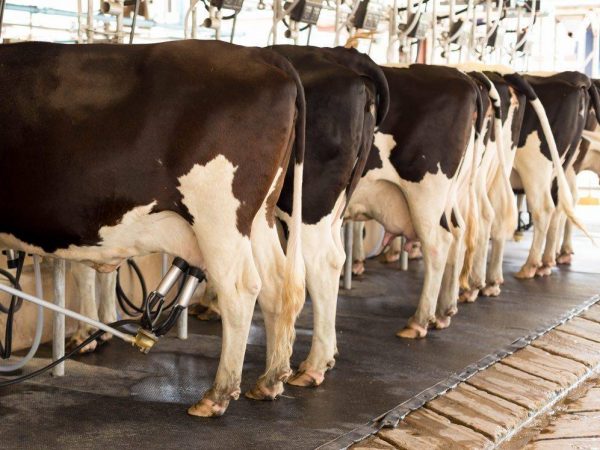Causes of streptoderma in cows
It is good to have a cow: always fresh milk, and, therefore, confidence in the quality of the product used. But this joy is only as long as the animal is healthy. But what if the horned one got sick? Cattle are susceptible to a limited number of diseases, streptoderma in cows is one of them. In essence, an ailment is a lesion of the skin by pathogenic microorganisms. Most often it is streptococcus. So what do you do in this case?

Streptoderma in cows
First impression
Streptoderma is externally recognizable by the presence of small flaky pinkish spots on the skin of the animal, especially on the udder. The disease is dangerous for the whole body. A cow can become infected by contact with other cows. But it is important to know that bacteria can also be transmitted to humans. At the first symptoms, you should call your veterinarian.
Most often, the incubation period lasts about seven days. At this time, nothing can still be suspected, but after a week the acute phase immediately sets in. Here vigilance of the owners and urgent treatment are needed, otherwise streptoderma will become a chronic disease and spread further along the skin. The disease is most pronounced on the udder and in the nipple area. In these places, cows develop ulcers and wounds, and in especially advanced cases, purulent foci appear. This is very difficult to treat, therefore it is so important to immediately, without delay, provide qualified assistance.
Symptoms and causes
Spots appear not only on the udder, but also near the ears and eyes, and also on the legs. Their size depends on the neglect of the disease and sometimes reaches 4 cm. The color of the spots is pinkish, and the skin in these places is rough to the touch. Later, bubbles appear, and after a while sores with crusts form. To relieve constant itching in cows is obtained by licking wounds with the tongue. When the crusts fall off, the skin looks even worse - covered with wounds. Streptoderma in cows shows the same symptoms as in humans. A quickly and completely healed animal is not immune from re-infection. But it is worse if the cow is not cured: then the risk of re-infection doubles. The causes of infection include:
- weakened immunity in an animal;
- mechanical damage to the skin;
- any bites (insects or animals);
- ingress of microbes.
You may notice lethargy and anxiety in cows, as well as a desire to rub against something. It arises from the fact that the affected parts of the body itch. This is dangerous because it can rub these places to blood and aggravate the clinical picture. A decrease in immunity can be provoked by:
- poisoning;
- hunger;
- stress;
- complications from other infections;
- lack of vitamins and minerals.
In any case, you need to hurry to a specialist: the earlier the treatment starts, the sooner it will help.
What to do, how to treat
First, the veterinarian will conduct an examination, make a diagnosis, and only then will he tell you what to do. If you applied immediately, then anti-inflammatory drugs and antiseptics will probably be enough.In case of neglect of the disease, antibiotics will be needed. They select special ones that fight against bacteria of this particular type. It will pass faster if you pierce the bubbles and treat these areas with an antiseptic.
A bandage is applied on top with Levomekol or Erythromycin ointments. If the first symptoms have just become noticeable, you need to immediately make wet dressings soaked in a 2% resorcinol preparation. High concentration can lead to burns. It is best to attach the dressings with a plaster, change every 15 minutes. It is important to try to do everything very carefully so as not to infect. If it does not help, antibiotics will have to be taken anyway. But self-medication is unacceptable, it is important to agree with a specialized specialist.
Streptoderma is a very serious disease, so you can't count on a quick result. The main thing is to provide good care and adhere exactly to all the doctor's recommendations, only in this way the animal will recover faster. Patience should be exercised and constant monitoring of the cow should be carried out. Both the animal and the human body equally need care and attention.
Prevention is better than cure
We now turn to the description of preventive measures. If a cow gets sick, it needs to be isolated from all domestic animals and even more so from the herd. Precautions will help prevent infection from entering the human body. Examination and procedures of a sick animal should be carried out with gloves. An antiseptic should be used to treat the location of the cow, and regular preventive examination of livestock and vaccination will help reduce the risk of infection.
You should look closely to those places where the first foci of the disease are likely to appear: skin, udder, nipples. Good nutrition, balanced and of high quality, will help animals develop good immunity, which is also an excellent prevention. In addition, the presence of boiled water should be monitored.
Finally
Adhering to simple rules for caring for animals, you can sleep peacefully and not worry. A healthy herd is the key to getting good offspring. Proper care, selected food, sufficient drinking water, prevention, and, if necessary, timely treatment - that's all the cow owner needs to know, and then neither streptoderma nor other diseases will most likely threaten the pets.


